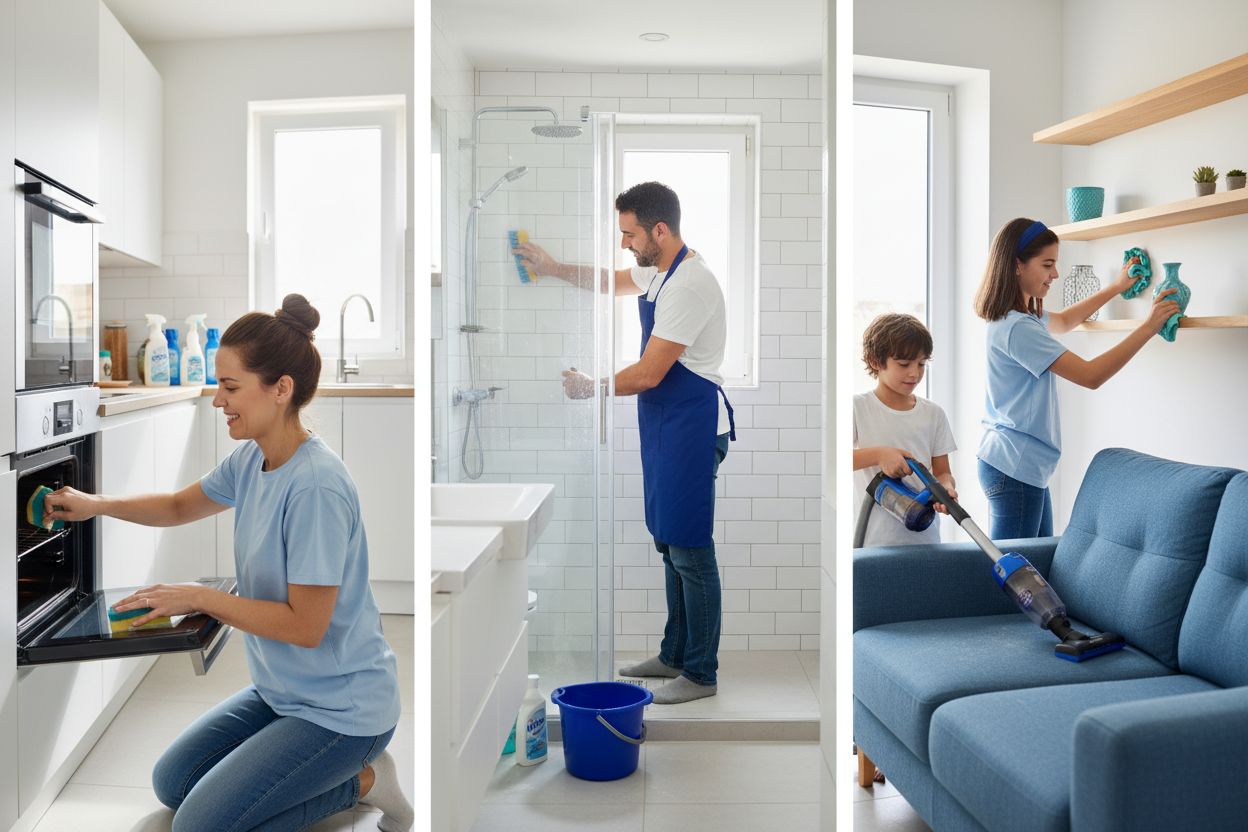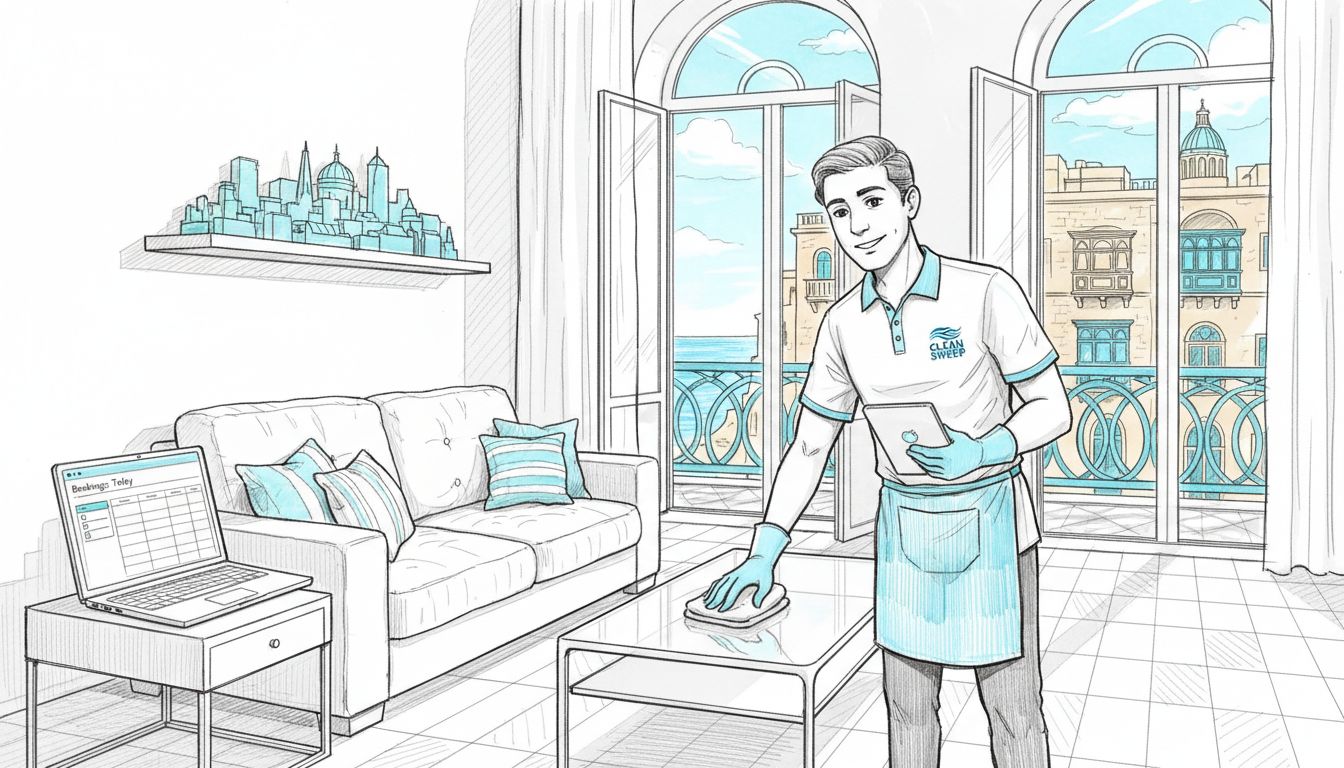Did you know kitchen appliance surfaces can harbor more bacteria than a toilet seat when not cleaned thoroughly? Many families overlook the hidden grime in common spaces, risking health and comfort without realizing it. With smart, focused cleaning habits, you can protect your home from germs and allergens while extending the life of your favorite appliances and furnishings.
Quick Summary
| Takeaway | Explanation |
|---|---|
| 1. Deep clean kitchen appliances regularly. | Maintaining hygiene in kitchen appliances prevents bacteria growth and ensures optimal performance. |
| 2. Use specialized cleaning solutions for tiles and grout. | Specific cleaners effectively remove soap scum and mildew, maintaining a safe and pleasant bathroom. |
| 3. Implement systematic dusting techniques. | Thorough dusting of hidden areas reduces allergies and improves air quality in your home. |
| 4. Utilize HEPA filters for upholstery cleaning. | HEPA filter vacuums effectively capture dust mites and allergens, enhancing your indoor health environment. |
| 5. Organize and sanitize storage areas regularly. | Decluttering and cleaning storage spaces enhances functionality and reduces potential health risks. |
Table of Contents
- Deep Cleaning Kitchen Appliances For Hygiene
- Scrubbing Bathroom Tiles And Grout Thoroughly
- Detailed Window And Curtain Cleaning Methods
- Washing And Disinfecting Hard-To-Reach Floors
- Deep Dusting Shelves, Vents, And Baseboards
- Mattress And Upholstery Deep Cleaning Explained
- Decluttering And Sanitizing Storage Areas
1. Deep Cleaning Kitchen Appliances for Hygiene
Kitchen appliances are silent harbors for bacteria and grime that can compromise your family’s health. Deep cleaning these essential machines goes beyond surface wiping—it’s about creating a genuinely hygienic cooking environment.
Most people underestimate how quickly kitchen appliances like ovens, refrigerators, and dishwashers accumulate hidden dirt. According to research from our guide on kitchen deep cleaning, these surfaces can harbor more bacteria than a toilet seat if not properly maintained.
Key areas to focus on during deep cleaning include:
• Oven interior and door seals
• Refrigerator shelves and drawers
• Dishwasher filters and rubber gaskets
• Microwave interior
• Stovetop grates and burners
According to manufacturers like Teka Group, regularly cleaning appliance interiors using manufacturer recommended cleaners maintains both hygiene and performance. This means removing grease buildup, sanitizing surfaces, and checking for potential wear that could compromise appliance efficiency.
Practical deep cleaning involves more than just wiping surfaces. You need systematic approaches: disassemble removable parts, use appropriate cleaning solutions, and pay attention to often overlooked areas like door seals and hidden crevices. Pro tip: Invest in microfiber cloths and specific appliance cleaning products for best results.
By dedicating time to thorough appliance maintenance, you protect your family’s health and extend the lifespan of your kitchen equipment. Regular deep cleaning prevents bacterial growth, eliminates unpleasant odors, and ensures your appliances perform at their best.
2. Scrubbing Bathroom Tiles and Grout Thoroughly
Bathroom tiles and grout are magnets for moisture, soap scum, and bacteria—creating perfect breeding grounds for mold and mildew. Deep cleaning these surfaces is not just about aesthetics but maintaining a healthy home environment.
Grimebuilt up in bathroom tiles represents more than just an unsightly problem. Neglected grout lines can become permanent stain zones that harbor harmful microorganisms. Our comprehensive cleaning guide emphasizes the critical nature of regular thorough cleaning.
Effective tile and grout cleaning requires strategic approaches:
• Use specialized cleaning solutions
• Apply targeted scrubbing techniques
• Protect grout from future staining
• Ventilate bathroom after cleaning
According to recent product research, specialized cleaning agents like Astonish Mould & Mildew Remover can rapidly restore grout whiteness with minimal manual scrubbing. This demonstrates how modern cleaning technologies can simplify what was once a labor intensive task.
Recommended cleaning process:
• Select a pH neutral cleaner appropriate for your tile type
• Apply cleaning solution and let sit for recommended duration
• Use soft bristle brush for gentle but thorough scrubbing
• Rinse thoroughly with clean water
• Dry surfaces completely to prevent moisture retention
Professional cleaners recommend addressing grout maintenance every 6 to 12 months. Consistent care prevents permanent staining and potential structural damage caused by moisture penetration. Pro tip: Consider applying grout sealer after deep cleaning to create a protective barrier against future stains and moisture absorption.
By investing time in systematic tile and grout maintenance, you protect your bathroom surfaces, prevent potential health risks, and maintain a sparkling clean living space.
3. Detailed Window and Curtain Cleaning Methods
Windows and curtains are often overlooked during cleaning routines, yet they dramatically impact your home’s overall appearance and air quality. Deep cleaning these surfaces requires strategic approaches that go beyond simple wiping.
Window cleaning techniques in Malta emphasize the importance of systematic cleaning that addresses both interior and exterior surfaces. Dust, salt spray, and environmental pollutants can quickly accumulate, making regular maintenance crucial.
Window cleaning essentials include:
• Microfiber cloths for streak free results
• Appropriate cleaning solutions
• Systematic cleaning techniques
• Proper drying methods
European cleaning research highlights innovative approaches like Window Wonder Outdoor cleaner, which offers a no scrub streak free formula ideal for hard to reach windows. This demonstrates how modern cleaning technologies can simplify traditionally challenging tasks.
For curtains, professional cleaners recommend specific care strategies. Fabric type determines cleaning method: delicate materials require gentle hand washing, while more robust fabrics can withstand machine cleaning. Pro tip: Always check manufacturer labels before washing.
Recommended curtain cleaning steps:
• Remove curtains carefully
• Check fabric care instructions
• Vacuum using soft brush attachment
• Spot clean stains before full washing
• Air dry or use low heat settings
Biannual deep cleaning of external blinds using gentle detergent helps maintain their condition and appearance. Regular maintenance prevents dust buildup and extends the lifespan of your window treatments.
By dedicating time to thorough window and curtain cleaning, you create a brighter, fresher living environment that enhances both aesthetic appeal and indoor air quality.
4. Washing and Disinfecting Hard-to-Reach Floors
Some floor areas become breeding grounds for bacteria and dirt due to their challenging locations. Hard-to-reach floor spaces require strategic cleaning approaches that go beyond standard mopping techniques.
Our comprehensive carpet cleaning guide highlights the importance of thorough floor maintenance, especially in areas that typically get overlooked during routine cleaning.
Common challenging floor areas include:
• Behind heavy furniture
• Under refrigerators and appliances
• Corners of rooms
• Tight spaces near walls
• Around toilet bases
Effective cleaning strategies for difficult floor zones:
• Use extendable cleaning tools
• Invest in slim microfiber mops
• Remove movable furniture periodically
• Employ vacuum attachments for tight spaces
• Consider specialized cleaning accessories
Proper floor disinfection goes beyond surface cleaning. Microorganisms can thrive in neglected areas, potentially creating health risks for your household. Systematic approach matters. Start by removing loose debris using a vacuum with slim attachments, then apply appropriate cleaning solutions designed for specific floor materials.
Pro tip: Rotate and move large furniture at least twice a year to clean underneath completely. This prevents dust accumulation and potential pest habitats.
Thorough floor cleaning requires patience and the right tools. Different floor materials wood, tile, linoleum demand specific cleaning techniques. Always test cleaning solutions in small areas first and follow manufacturer recommendations for your specific flooring type.
By dedicating time to these often forgotten floor zones, you create a genuinely clean living environment that looks better and supports your family’s health.
5. Deep Dusting Shelves, Vents, and Baseboards
Dust accumulation in overlooked areas can transform your home into an invisible allergen zone. Deep dusting of hidden surfaces is more than a cosmetic task—it’s a critical health maintenance strategy.
Manufacturers like Miele have developed specialized cleaning tools that underscore the importance of reaching difficult areas. Our spring cleaning guide provides comprehensive insights into systematic dust removal techniques.
Areas most prone to dust accumulation:
• Decorative shelf edges
• Air conditioning vents
• Wooden baseboards
• Top of picture frames
• Ceiling fan blades
Kitchen ventilation systems demand particular attention. According to Teka Group research, range hood vents and filters require regular deep cleaning to prevent grease buildup and maintain efficient operation.
Effective deep dusting strategies:
• Use microfiber cloths for superior dust capture
• Employ extendable cleaning tools
• Work from top to bottom
• Use soft brush vacuum attachments
• Clean systematically to avoid redistributing dust
Pro tip: Invest in a high quality vacuum with multiple attachments. This allows you to reach corners, crevices, and elevated surfaces that traditional cleaning methods miss.
Consistent dust removal prevents respiratory issues, reduces allergen levels, and maintains your home’s overall cleanliness. Different surfaces require different approaches: delicate wooden shelves need soft microfiber cloths, while robust baseboards can handle slightly more aggressive cleaning techniques.
By dedicating time to comprehensive dust removal, you create a healthier living environment that looks and feels genuinely clean.
6. Mattress and Upholstery Deep Cleaning Explained
Your mattress and upholstery are silent collectors of dust, dead skin cells, and microscopic organisms that can compromise your health and comfort. Deep cleaning these fabric surfaces goes far beyond simple vacuuming.
Our comprehensive move-in cleaning guide emphasizes the critical importance of thorough fabric sanitization, especially for surfaces where we spend significant time.
Major concerns with unclean fabrics:
• Dust mite accumulation
• Allergen buildup
• Potential skin irritation
• Unpleasant odors
• Reduced furniture lifespan
Manufacturers like Miele have developed specialized vacuum attachments with HEPA filtration specifically designed for deep fabric cleaning. These tools effectively remove microscopic particles that standard cleaning methods might miss.
Effective mattress and upholstery cleaning techniques:
• Use HEPA filter vacuum attachments
• Apply fabric specific cleaning solutions
• Steam clean periodically
• Rotate and air out mattresses
• Use protective covers
Pro tip: Aim to deep clean mattresses and upholstery every 6 months. Central European cleaning standards recommend hot water extraction methods for thorough sanitization.
Specific fabric types require tailored approaches. Leather needs different treatment compared to cotton or synthetic materials. Always check manufacturer labels and test cleaning solutions in small inconspicuous areas first.
By investing time in systematic fabric deep cleaning, you create a healthier sleeping environment, extend the life of your furniture, and significantly improve overall indoor air quality.
7. Decluttering and Sanitizing Storage Areas
Storage areas are magnets for dust, bacteria, and forgotten items that accumulate over time. Systematic decluttering and sanitization transforms chaotic spaces into organized, hygienic zones that support mental clarity and efficient living.
Our guide on cleaning time management emphasizes how organized storage directly impacts overall home maintenance efficiency.
Warning signs your storage needs attention:
• Difficulty finding items
• Visible dust buildup
• Musty odors
• Overcrowded shelves
• Expired or unused products
Miele storage design principles highlight the importance of accessible, clean spaces. Their approach demonstrates how organization combines aesthetic appeal with practical functionality.
Effective decluttering and sanitizing steps:
• Remove everything from storage area
• Sort items into keep discard donate piles
• Clean surfaces with mild soap solution
• Use microfiber cloths for dust removal
• Implement organizational systems
• Sanitize thoroughly before restocking
Pro tip: European maintenance guidelines recommend avoiding harsh chemicals. Use gentle cleaning solutions that preserve material integrity while ensuring thorough sanitization.
Periodic deep cleaning of storage areas prevents pest infestations, reduces allergen accumulation, and creates a more functional living environment. Different storage zones kitchens closets garages require tailored approaches based on their specific contents and usage patterns.
By dedicating time to systematic decluttering and sanitization, you create spaces that are not just clean but genuinely functional and stress reducing.
Below is a comprehensive table summarizing the deep cleaning strategies discussed throughout the article to maintain hygiene and efficiency in various home environments.
| Task | Key Areas & Actions | Benefits/Outcomes |
|---|---|---|
| Kitchen Appliance Deep Cleaning | Focus on oven interior, refrigerator shelves, dishwasher filters, etc.; Use recommended cleaners and microfiber cloths | Maintains hygiene, extends appliance lifespan, prevents bacterial growth |
| Bathroom Tile and Grout Cleaning | Use specialized solutions; Targeted scrubbing; Ventilation post-cleaning | Prevents mold, maintains aesthetics, avoids structural damage |
| Window and Curtain Maintenance | Use microfiber cloths; Check fabric care labels; Machine or hand wash based on material | Improves air quality and appearance, prevents dust accumulation |
| Cleaning Hard-to-Reach Floors | Use extendable tools and slim mops; Rotate furniture; Appropriate solutions for each floor type | Reduces health risks, prevents dust and pest habitats |
| Deep Dusting of Shelves and Vents | Use microfiber cloths; Extendable tools; Top to bottom approach | Reduces allergens, maintains cleanliness, prevents respiratory issues |
| Mattress and Upholstery Cleaning | HEPA filter vacuums; Steam cleaning; Rotate mattresses | Improves air quality, extends furniture life, reduces allergens |
| Decluttering and Sanitizing Storage | Sort items; Use microfiber cloths for dust removal; Implement organization systems | Enhances functionality, reduces stress, prevents pest infestations |
Take the Stress Out of Deep Cleaning in Malta
Are you struggling to keep up with kitchen grease, tile grime, or dust that never seems to disappear? Busy Maltese households often find deep cleaning overwhelming, especially when juggling work and family. As this article shows, even hidden corners, vents, and mattresses need attention for a truly healthy home. That is where having a trusted, professional solution makes all the difference.
Explore top cleaning options in Malta

With Rozie.app, you can find a verified cleaner or cleaning company online, whenever you need. Book a deep clean in just a few taps and enjoy peace of mind knowing Rozie supports you seven days a week. There is no time like now to experience a spotless home, without sacrificing your weekends. Visit Rozie.app to book your next deep clean or read helpful tips and insights at our Rozie Blog.
Frequently Asked Questions
What are effective methods for deep cleaning kitchen appliances?
Deep cleaning kitchen appliances can be done by removing grease buildup and sanitizing surfaces. Focus on areas like the oven interior, refrigerator shelves, and dishwasher filters at least once every three months for optimal hygiene.
How do I deep clean bathroom tiles and grout?
To deep clean bathroom tiles and grout, apply a pH neutral cleaner and let it sit for the recommended duration before scrubbing gently with a soft bristle brush. Rinse thoroughly to prevent moisture retention and maintain a sparkling finish every 6 to 12 months.
What steps should I follow to clean windows and curtains?
Start by removing the curtains and checking their fabric care instructions, then vacuum them with a soft brush attachment. For windows, use a microfiber cloth with a suitable cleaning solution, cleaning from top to bottom to ensure a streak-free finish every 6 months.
How can I clean hard-to-reach floors effectively?
Use extendable cleaning tools and slim microfiber mops to reach areas behind heavy furniture and tight spaces near walls. Perform deep cleaning in these areas at least twice a year to eliminate dirt and bacteria accumulation.
What is the best way to deep dust shelves, vents, and baseboards?
Use microfiber cloths and extendable cleaning tools to systematically dust these areas from top to bottom. Plan to deep dust these surfaces quarterly to prevent allergen buildup and maintain overall home cleanliness.
How do I deep clean mattresses and upholstery?
To deep clean mattresses and upholstery, vacuum them with a HEPA filter attachment and apply fabric-specific cleaning solutions. Perform this thorough cleaning at least every 6 months to ensure a healthy sleeping environment and improve indoor air quality.
Recommended
- Maid Service in Malta: 10 Cleaning Hacks for Maltese Homes
- Effortless Weekly Cleaning Routine for Busy Professionals | Rozie – Malta’s Best Cleaning Services
- Create a House Cleaning Schedule Daily Weekly Monthly for 2025 | Rozie – Malta’s Best Cleaning Services
- 7 Essential Tips for Your Household Cleaning Planner | Rozie – Malta’s Best Cleaning Services



